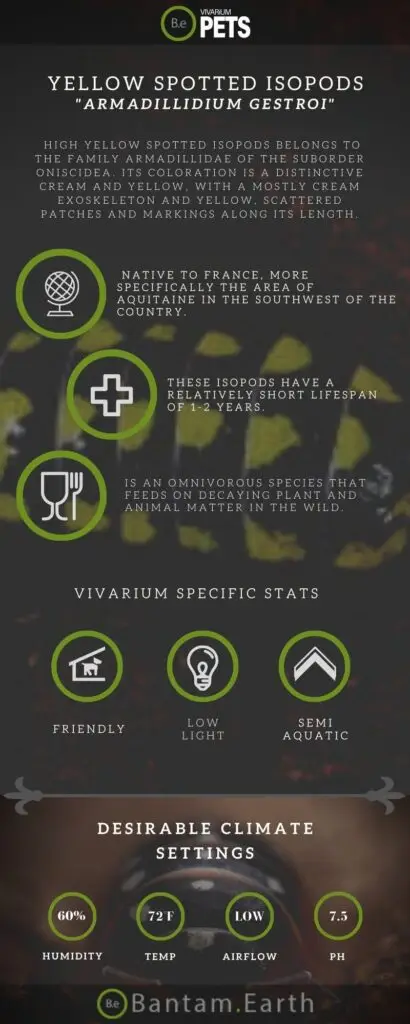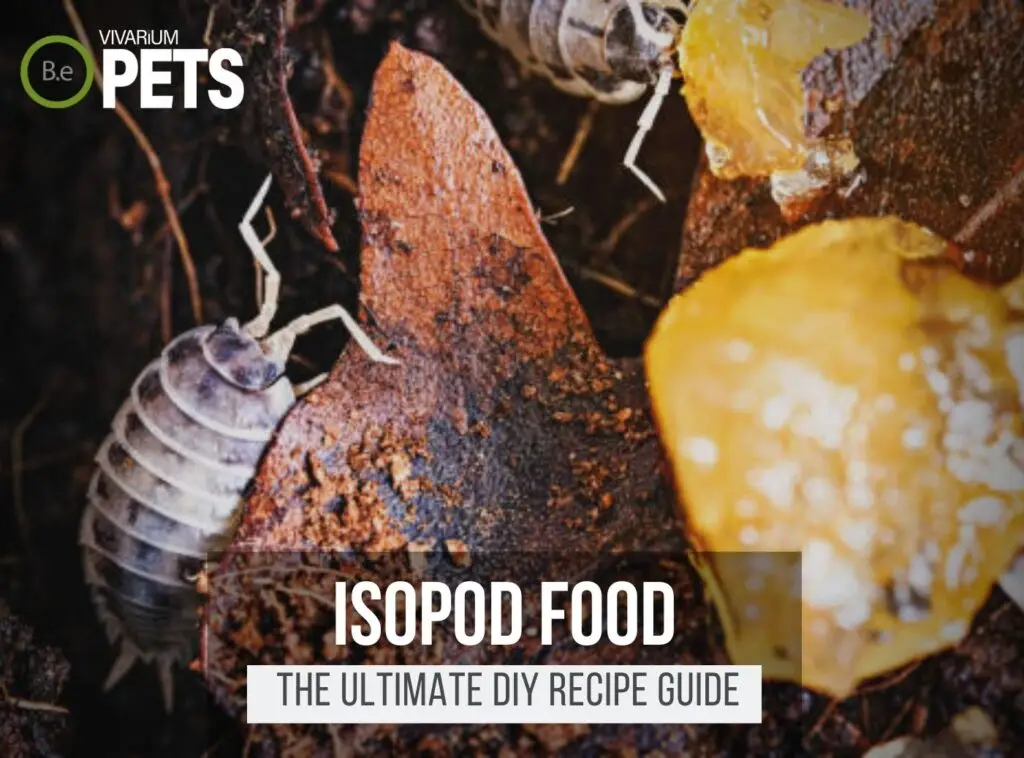Welcome to the wonderful world of High Yellow Spotted Isopods (Armadillidium gestroi) care!
Armadillidium gestroi is one of the most interesting and hardy isopods that you can keep as a pet.
Native to regions in the Mediterranean and areas of Southern Europe, they are commonly known as “pillbugs” or “roly-polies” and make a fascinating addition to any home.
In this guide, we’ll show you how to set up a suitable habitat for them, provide them with the ideal diet, maintain their environment, and handle and breed them. Let’s jump in!
| Characteristics: | |
|---|---|
| Common Name | High Yellow Spotted Isopod, Woodlice |
| Family Name | Armadillidiidae |
| Scientific Name | Armadillidium gestroi |
| Use | Cleaning, Aerating Soil, Feeders |
| Temperament | Non-aggressive |
| Lifespan | 1-2 Years |
| Diet | Detritivore |
| Adult Size | 4 - 8 mm |
| Breeding Type | Egg Layer |
| Care Level | Easy |
| Minimum Tank Size | 2-5 Gallons |
| pH | 7.2-8.0 |
| Hardness | Soft to medium |
| Temperature | 68-77°F |
What Are High Yellow Spotted Isopods?
Armadillidium gestroi, more commonly known as High Yellow Spotted Isopods, belong to the family Armadillidae of the suborder Oniscidea.
This species of isopod gets its common name from the yellow, scattered markings it displays on its back as well as its ability to curl into a ball like an armadillo.
Found in France, it is a popular species for terrariums due to its ease of care and impressive appearance.
What Does Armadillidium gestroi Look Like?
Armadillidium gestroi is a relatively small isopod with a length ranging from 14 to 18 mm.
Its coloration is a distinctive cream and yellow, with a mostly cream exoskeleton and yellow, scattered patches and markings along its length.
As individuals reach maturity, their color will gradually darken to more of a brown hue.
The exoskeleton of Armadillidium gestroi is rounded as opposed to flattened like more common Porcellio isopods, giving them a more pill-shaped appearance.
They have seven pairs of bean-shaped legs, with the last pair being slightly longer in order to allow them to curl into a ball for protection.
Their antennae are long and slender, and their smell-detecting glandular organs are located on their fifth legs and antennae.
Benefits Of Using High Yellow Spotted Isopods
Armadillidium gestroi are popularly used in vivariums because they are hardy, attractive, and easily cared for.
Their bright yellow spots against their dark body are visually appealing, and they add a lot of movement to the habitat.
They are important members of the bioactive terrarium’s food chain, providing vital roles in disease control and decomposition.
Some owners keep Armadillidium gestroi as pets and handle them in creative ways such as adding them to an enclosure with live terrarium plants.


High Yellow Spotted Isopods Facts
Armadillidium gestroi is an attractive, easy-to-care-for omnivorous isopod native to France. In the wild, they feed on carrion and decaying plant material.
They are relatively easy to maintain and handle and can live up to two years with proper care.
Breeding can be achieved with enough food and a proper moisture-rich environment.
Habitat
Armadillidium gestroi are native to France, more specifically the area of Aquitaine in the southwest of the country.
Here, these isopods naturally inhabit the shrublands, woodlands, and forest edges, where they hide and forage among leaf litter and fallen logs.
At the base of tree trunks and in the shelter of stones and logs, one may find colonies of Armadillidium gestroi living together.
Armadillidium gestroi are distributed across Europe, Asia Minor, and North Africa, but the main population tends to be concentrated in southern Europe.
These isopods naturally prefer a humid and warm environment, with temperatures ranging between 59°F and 77°F.
Diet
Armadillidium gestroi is a detrivore species that feed on decaying plant and animal matter in the wild.
As scavengers, they consume a wide variety of 5 food sources such as dead insects, worms, decaying fruits, vegetables, and fungi.
This species also feeds on leaf litter, algae, and lichens in areas where this is available.
In order to thrive, they need to have a balanced diet with a good variety of all the food sources they would find in their natural habitat.
Temperament
Armadillidium gestroi are generally gentle and docile creatures, making them ideal for novice keepers.
In their natural environments, they can be found scurrying across the ground in search of food, so their ability to curl into a tightly packed ball when disturbed is an adaptation that helps them hide from predators.
Generally speaking, Armadillidium gestroi do not react to human contact, making them safe to handle.
These isopods are very shy creatures, so it’s important to provide them with plenty of hiding places in their habitat.
When facing unfamiliar creatures, Armadillidium gestroi may remain in their balled posture until they become accustomed to their surroundings.
If they feel safe enough to move around, they may begin to explore the area and form bonds with other animals or humans in their environment.
Lifespan
Armadillidium gestroi have an average lifespan of 1-2 years, however, with proper care, they can live up to 3 years.
To reach this lifespan, isopods rely on a few conditions, such as temperature and humidity. Isopods start their life cycle as an egg that is laid by the female.
Once the egg hatches, the juvenile will molt or shed its skin multiple times before becoming an adult.
During this time, the isopod will reach full size and its color will change to a deeper grayish brown.
Breeding
Armadillidium gestroi mating is a fascinating and complicated process.
The entire reproduction process takes around a month and can be divided into several distinct steps.
When two mature Armadillidium gestroi meet, they initially try to find out if the other is a suitable mate.
This is done by exchanging stimulating compounds from the bottom of the legs.
When a suitable mate is found, courtship begins, during which both partners use gentle nudging motions to express their intent.
In the next step, the partners complete a mating dance. During the dance, the male can initiate mating by clasping the female’s pereonites with his legs.
The male then deposits his sperm packet into the female’s genital opening.
As the sperm is introduced, the female begins pulsing the sperm packet with her muscles to spread the sperm throughout her reproductive tract.
Once fertilization is complete, the female will produce an egg capsule within a few days.
She will then attach the capsule to her abdomen, just in front of her legs, and carry it until the eggs hatch.
This complex reproductive cycle allows Armadillidium gestroi to thrive in various environments.
Where To Find High Yellow Spotted Isopods
Finding Armadillidium gestroi in the wild can be a challenging but rewarding endeavor.
This species is native to France and can be found near moist areas such as under leaves, rocks, and logs in a variety of habitats like woods, meadows, and lawns.
Since they are small and often well camouflaged, they can be very hard to spot.
It is also important to note that collecting isopods from the wild can lead to population depletion.
Armadillidium gestroi are widely available for sale in the United States, Europe, and Australia, usually sold in small colonies of several individuals.
Carefully inspect the isopods before you buy them, as they should be free from any parasites or contagious diseases.
Also, make sure you are purchasing from a reputable source and shop to ensure you are getting healthy specimens.
Finally, always research the rules and regulations of your region or state before purchasing or collecting isopods, as some areas may have laws prohibiting them.
High Yellow Spotted Isopods Care
To care for Armadillidium gestroi, one must establish an ideal habitat and ensure the isopods have access to the correct food, temperature, and humidity levels.
Additionally, the handling and breeding of this species should be done with care.
Regular health checks are also recommended, so potential issues can be identified and addressed.
Tank Requirements
When housing Armadillidium gestroi, they should be placed in a terrarium that is at least 5 gallons or larger.
The optimal vivarium type is one with a humid and warm environment with plenty of ventilation.
The pH should generally be balanced around 7.0-7.4 and the hardness should be around 4-6 dGH.
The temperature should reach 80°F (26°C) during the day and 70°F (20°C) at night.
The terrarium substrate should be kept moist but not wet and can be comprised of peat moss, and coco fiber.
The tank should be lit with low-intensity terrarium light, but not exposed to direct sunlight.
What Do High Yellow Spotted Isopods Eat?
Feeding your Armadillidium gestroi is an important part of keeping them healthy and happy. Ideally, you will want to offer them a variety of foods, including both plant and animal matter.
Examples of items they can eat include:
• Fruits: apples, kiwis, oranges, bananas, etc.
• Vegetables: Lettuce, bell pepper, carrots, etc.
• Cooked meats: Cooked shrimp, chicken, beef, etc.
• Store-bought isopod food
• Fish flakes
• Frozen Worms
• Decaying Crickets
As with all isopods, you should offer them food every other day to ensure they are receiving the nutrition they need.
If you’re more of an avid hobbyist like myself, be sure to check out my ultimate DIY Isopod food guide. I give a more in-depth explanation of the best foods and my personal favorite recipe.
Best Tankmates For High Yellow Spotted Isopods
Armadillidium gestroi are best kept with other species that are similar in size, climate, and food preferences.
Good tankmates for Armadillidium gestroi can include springtails, Dubia roaches, Zophobas morio larvae, and larvae from Composting Worms, such as Red Wigglers or Red Earthworms.
In addition to these tankmates, Armandillidium gestroi can also be kept with some species of land snails.
All these species have beneficial qualities for the terrarium and are beneficial for the health of Armadillidium gestroi.
This makes them excellent, peaceful tankmates for Armadillidium gestroi, while still contributing to the natural functioning of the tank.
Conclusion
In conclusion, Armadillidium gestroi, more commonly known as High Yellow Spotted Isopods, is a peculiar and fascinating creature.
They require a particular care regime of temperature and humidity levels, as well as a balanced diet in order to thrive.
With proper care, they are a great addition to any terrarium and are sure to impress all who come across them.
Frequently Asked Questions
To take care of an Isopod Gestroi, provide a moist habitat with food sources, and monitor the temperature, humidity, and health of your Isopod. Clean the tank regularly and mist with dechlorinated water, ensuring it is escape–proof.
The common name for Gestroi isopod is High Yellow Spotted Isopod.
Armadillidium gestroi are from the Mediterranean region and Western Europe.
You should feed Armadillidium gestroi (High Yellow Spotted Isopods) a diet consisting of leaf litter, decaying wood and soil, fruits, vegetables, and any other organic matter.

